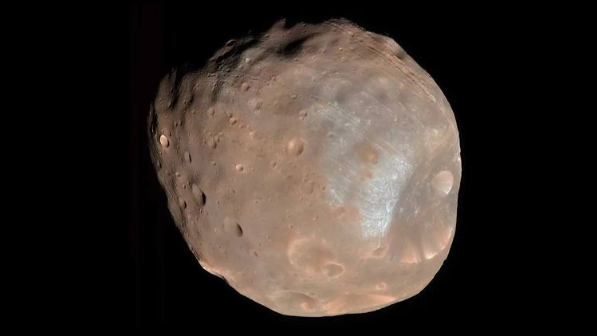'Space potato' spotted by NASA Mars satellite is actually something much cooler
The starchy-looking moon Phobos, destined to crash into Mars' surface, has been revealed in new detail by NASA's Mars Reconnaissance Orbiter. The 'space potato' image was recently shared on NASA's Instagram.

NASA has posted a stunning photo of a "space potato" on social media — but it is actually Phobos, the Martian moon that is locked on a slow collision course with the Red Planet.
The space agency imaged the lumpy, starchy-looking moon using the High Resolution Imaging Science Experiment (HiRISE) camera on board NASA's Mars Reconnaissance Orbiter, which has been studying the Red Planet since arriving in its orbit in 2006.
Phobos, named after the Greek god of fear, is roughly 157 times smaller than Earth's moon and is one of Mars' two natural satellites, alongside the even smaller Deimos, whose name comes from the Greek god of dread.
Scientists believe that the brother moons were once roaming rocks and were snared into Mars' orbit by the planet's gravitational field. A recent image analysis of Phobos' craggy yet highly reflective surface suggested the moon was once a comet and came from the asteroid belt located between the Red Planet and Jupiter.
Related: Hundreds of black 'spiders' spotted in mysterious 'Inca City' on Mars in new satellite photos
The two moons' orbits are unstable, and scientists predict that in tens of millions of years Deimos will spin out into space while Phobos will either break up into a ring or slam into the Martian surface.
However, with Phobos drifting only 6 feet (1.8 meters) closer to Mars every hundred years, our solar system's space potato is unlikely to be mashed for another 50 million years, according to NASA.
Sign up for the Live Science daily newsletter now
Get the world’s most fascinating discoveries delivered straight to your inbox.
That leaves us with plenty of time to study and admire the starchy celestial body, whose characteristic features include streaks of white ice and the Stickney Crater — a 6-mile (10 kilometers) indent named after Chloe Angeline Stickney Hall, the mathematician and wife of the two moons' discoverer Asaph Hall, who first oberved them in 1877.

Ben Turner is a U.K. based staff writer at Live Science. He covers physics and astronomy, among other topics like tech and climate change. He graduated from University College London with a degree in particle physics before training as a journalist. When he's not writing, Ben enjoys reading literature, playing the guitar and embarrassing himself with chess.










